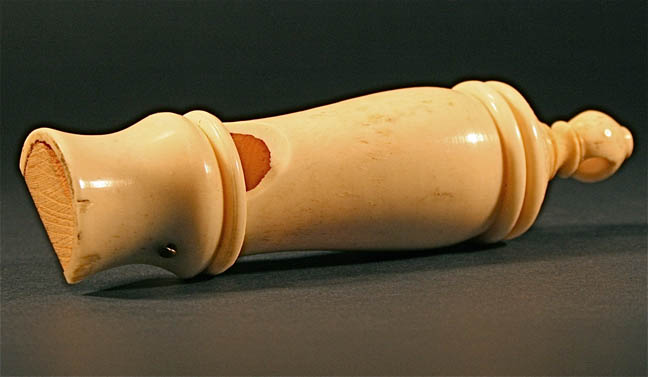

Title: Antique bone policeman blowing whistle
Shipping: $9.00
Artist: N/A
Period: 19th Century
History: N/A
Origin: N/A
Condition: Museum Quality
Item Date: 1800 to 1900
Item ID: 2747
This was standard-issue to all policemen in the 1800s. Antique policemen bone hand carved whistle, make a sound with this quality whistle. The mechanism assures high whistle sounds. Solid bone construction in a classic shape and natural finish. This is a policemen Victorian 1800s or earlier rare antique bone hand carved whistle. Whistles can be used for increase personal awareness of your surroundings, especially for seniors or women walking alone at night or during the early mornings. Police Whistle was the standard-issue whistle given to all policemen from the 1800s. The whistle was adopted by the Police Service in the 1800s when they were trying to find a suitable replacement for the bulky, heavy hand-rattles used by police at the time. The whistle was small, tough, easy to hold, with its distinctive, tubular design. Its size, weight, lack of moving parts and simplicity to use, made it the natural replacement to the rattle. When blown, the Whistle lets out a piercing, high-pitched, shrilling screech that, in open air on a quiet, windless day, can be heard up to two miles away. Over the noise of chatter and traffic, the sound of the whistle could be heard a lot easier than the clattering of a rattle. Most of these whistles where made of bone and then metal. Traditionally, they were secured by a hook and chain, to the officer's uniform and were used to summon backup or to gain attention. in the 1900s declared obsolete, and was replaced with radio. The noise generated by automotive traffic made the whistle hard to hear, and therefore, no-longer effective. The classic whistle", it is rare to hear it in the streets today as most policemen don't carry them anymore. If they are used, it's purely for ceremonial purposes.
Link: http://en.wikipedia.org/wiki/Whistle
A simple whistle is a woodwind instrument which produces sound from a stream of forced air. The whistle has its roots dating back to ancient China. Chinese night watchmen used to blow into the tops of acorns in order to alert the towns of invading Mongolians. In ancient Egypt two blades of the papyrus plant along the Nile river were held together in between the palms. By blowing into the palms the papyrus leaves would make a loud vibrant sound. The whistle works by causing the smooth flow of air to be split by a narrow blade, sometimes called a fipple, creating a turbulent vortex which causes the air to vibrate. By attaching a resonant chamber to the basic whistle, it may be tuned to a particular note and made louder. The length of the chamber typically defines the resonance frequency. A whistle may also contain a small light ball, usually called the pea, which rattles around inside, creating a chaotic vibrato effect that intensifies the sound. Japanese bird whistles use several small balls and are half filled with water in order to reproduce the sound of a bird song.